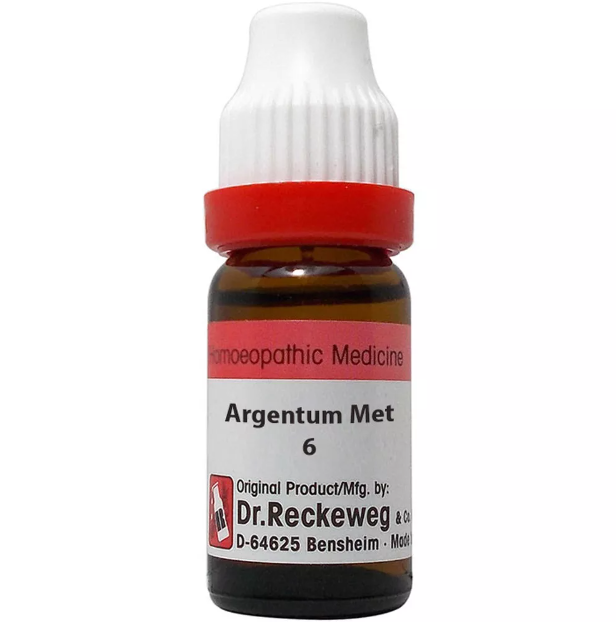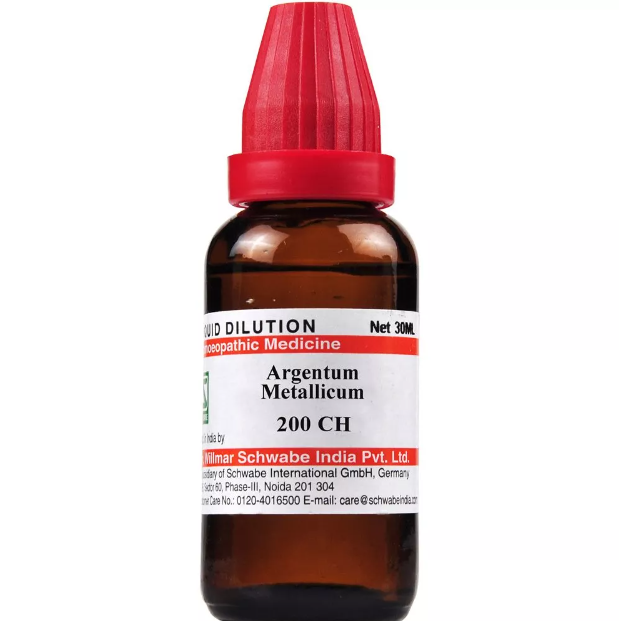ARGENTUM METALLICUM 6C, 12C, 30C, 200C, 1M, 10M USES AND SYMPTOMS
 Emaciation, desire for fresh air, dyspnea, left-sided pains, and sensation of expansion. Primarily affects joints, bones, cartilages, and ligaments. Exostosis common. Gradual, lingering onset of symptoms.
Emaciation, desire for fresh air, dyspnea, left-sided pains, and sensation of expansion. Primarily affects joints, bones, cartilages, and ligaments. Exostosis common. Gradual, lingering onset of symptoms.
Mind: Feeling hurried; time perception altered; melancholy.
Head: Dull paroxysmal neuralgia on left side (migraine), increasing gradually and stopping suddenly. Scalp tender to touch. Vertigo near running water. Empty, hollow sensation in head (brain fag).
Eyes: Red, thick eyelids (blepharitis). Pain between left eye and frontal eminence.
Nose: Exhausting coryza with sneezing.
Face: Facial bone pain.
Throat: Raw, hawking, gray, jelly-like mucus. Sore throat on coughing. Profuse morning expectoration.
Urinary: Diuresis. Turbid, sweet-smelling urine. Frequent micturition. Polyuria.
Male: Testicular pain. Seminal emissions without excitement. Burning with frequent micturition.
Female: Enlarged ovaries, bearing down pain, prolapse of uterus. Eroded, spongy cervix. Foul, excoriating leucorrhea. Palliative in uterine scirrhus. Left ovarian pain. Climacteric hemorrhage. Abdominal soreness, worsened by jarring. Uterine disease with joint and limb pain.
Respiratory: Hoarseness, aphonia. Raw, sore feeling on coughing. Total loss of voice, especially in singers. Sore, raw larynx. Easy expectoration resembling boiled starch. Raw spot near supra-sternal fossa. Worse from voice use. Cough on laughing. Chest weakness, worse left side. Change in voice timbre. Pain in left lower ribs.
Back: Severe backache, walking bent with chest oppression.
Extremities: Rheumatic joint affections, especially elbow and knee. Weak, trembling legs, worse descending stairs. Involuntary finger contractions, forearm partial paralysis. Swollen ankles.
Modalities: Worse from touch, noon; better in open air. Night cough lying down (opposite Hyos.).
Relationship: Antidotes: Merc., Puls. Similar to Sel., Alum., Plat., Stann., Ampelopsis quinquefolia (chronic hoarseness in scrofulous patients).
Dose: Sixth trituration and higher. Avoid frequent repetition.
SYMPTOMS OF ARGENTUM METALLICUM
Characteristic Symptoms: Emaciation, desire for fresh air, dyspnea, left-sided pains, sensation of expansion. Primarily affects joints, bones, cartilages, and ligaments. Exostosis common. Gradual, lingering onset of symptoms.
Mind: Feeling hurried; altered time perception; melancholy.
Head: Dull paroxysmal neuralgia on left side (migraine), gradually increasing and ceasing suddenly. Scalp tender to touch. Vertigo near running water. Empty, hollow sensation in head (brain fag).
Eyes: Red, thick eyelids (blepharitis). Pain between left eye and frontal eminence.
Nose: Exhausting coryza with sneezing.
Face: Facial bone pain.
Throat: Raw, hawking, gray, jelly-like mucus. Sore throat on coughing. Profuse morning expectoration.
Urinary: Diuresis. Turbid, sweet-smelling urine. Frequent micturition. Polyuria.
Male: Testicular pain. Seminal emissions without excitement. Burning with frequent micturition.
Female: Enlarged ovaries, bearing down pain, prolapse of uterus. Eroded, spongy cervix. Foul, excoriating leucorrhea. Palliative in uterine scirrhus. Left ovarian pain. Climacteric hemorrhage. Abdominal soreness, worsened by jarring. Uterine disease with joint and limb pain.
Respiratory: Hoarseness, aphonia. Raw, sore feeling on coughing. Total loss of voice, especially in singers. Sore, raw larynx. Easy expectoration resembling boiled starch. Raw spot near supra-sternal fossa. Worse from voice use. Cough on laughing. Chest weakness, worse left side. Change in voice timbre. Pain in left lower ribs.
Back: Severe backache, walking bent with chest oppression.
Extremities: Rheumatic joint affections, especially elbow and knee. Weak, trembling legs, worse descending stairs. Involuntary finger contractions, forearm partial paralysis. Swollen ankles.
Modalities: Worse from touch, noon; better in open air. Night cough lying down (opposite Hyos.).
Relationship: Antidotes: Merc., Puls. Similar to Sel., Alum., Plat., Stann., Ampelopsis quinquefolia (chronic hoarseness in scrofulous patients).
Dose: Sixth trituration and higher. Avoid frequent repetition.
selection of the potency
Individualization:
- Homeopathy is based on the principle of treating the individual, not just the disease. The unique symptoms and characteristics of the person are crucial in determining the most suitable potency.
Intensity of Symptoms:
- The intensity of the symptoms guides the choice of potency. If the symptoms are intense and acute, a lower potency (e.g., 6C, 30C) might be considered. For chronic conditions with less intensity, higher potencies (e.g., 200C, 1M) may be appropriate.
Sensitivity of the Patient:
- Some individuals are more sensitive to homeopathic remedies, while others may require higher potencies. The practitioner considers the patient’s sensitivity when selecting the potency.
Acute vs. Chronic Conditions:
- Lower potencies are often used for acute conditions, while higher potencies may be considered for chronic or long-standing issues.
Previous Response to Potencies:
- The patient’s response to previous homeopathic treatments helps guide the choice of potency. If a particular potency has been effective in the past, it may be repeated or adjusted as needed.
Vital Force and Susceptibility:
- Homeopathy views illness as a disturbance in the vital force. The practitioner assesses the patient’s overall vitality and susceptibility to determine the appropriate potency.
Aggravation or Amelioration:
- The direction of the symptom response (aggravation or amelioration) after taking a remedy can influence the choice of potency.
Miasmatic Considerations:
- In classical homeopathy, the concept of miasms (inherited disease tendencies) is considered. The practitioner take this into account when selecting the potency.
Practitioner Experience:
- The experience and preference of the homeopathic practitioner play a role. Some practitioners may have success with certain potencies based on their clinical experience.
SAFETY INFORMATION
- Do not exceed the recommended dose by physician
- Keep out of the reach of children
- Store in a cool dry place away from direct sunlight
- Maintain half an hour gap between food/drink/any other medicines and homoeopathic medicine
- Avoid any strong smell in the mouth while taking medicine e.g. camphor, garlic, onion, coffee, hing
Medicine images use for reference only selection of homeopathic medicine depends on the individual’s specific symptoms and overall constitution. Moreover, homeopathy is a holistic system of medicine that treats the individual as a whole. In addition to addressing the physical symptoms, it takes into account the emotional and mental state of the person. Consequently, it’s crucial to consult with a qualified homeopathic practitioner for personalized treatment.
The information provided on this website is intended solely for educational purposes. Always seek the advice of your physician or other qualified health provider.
